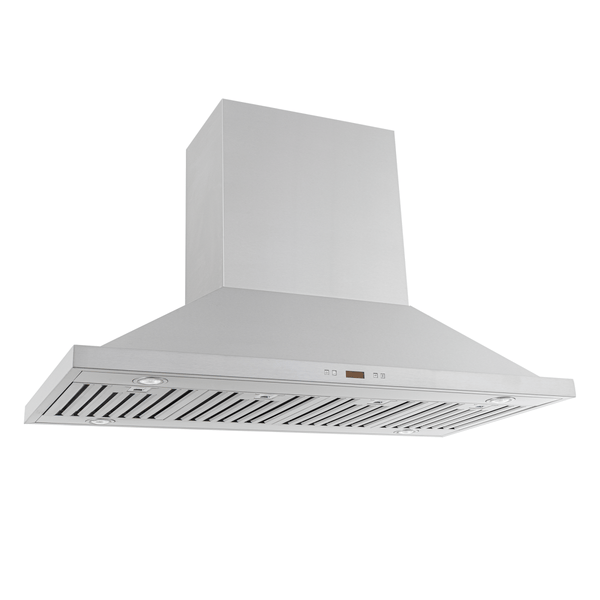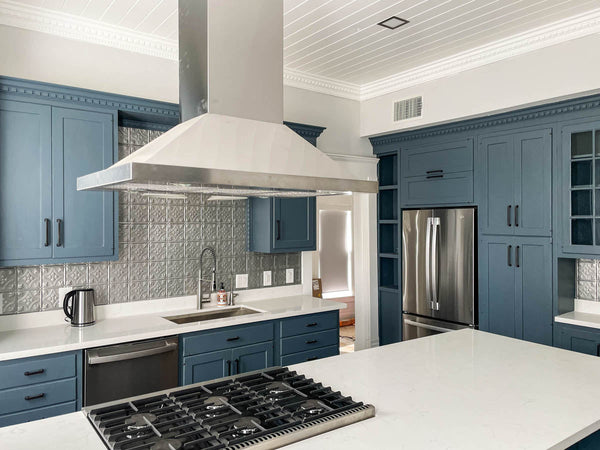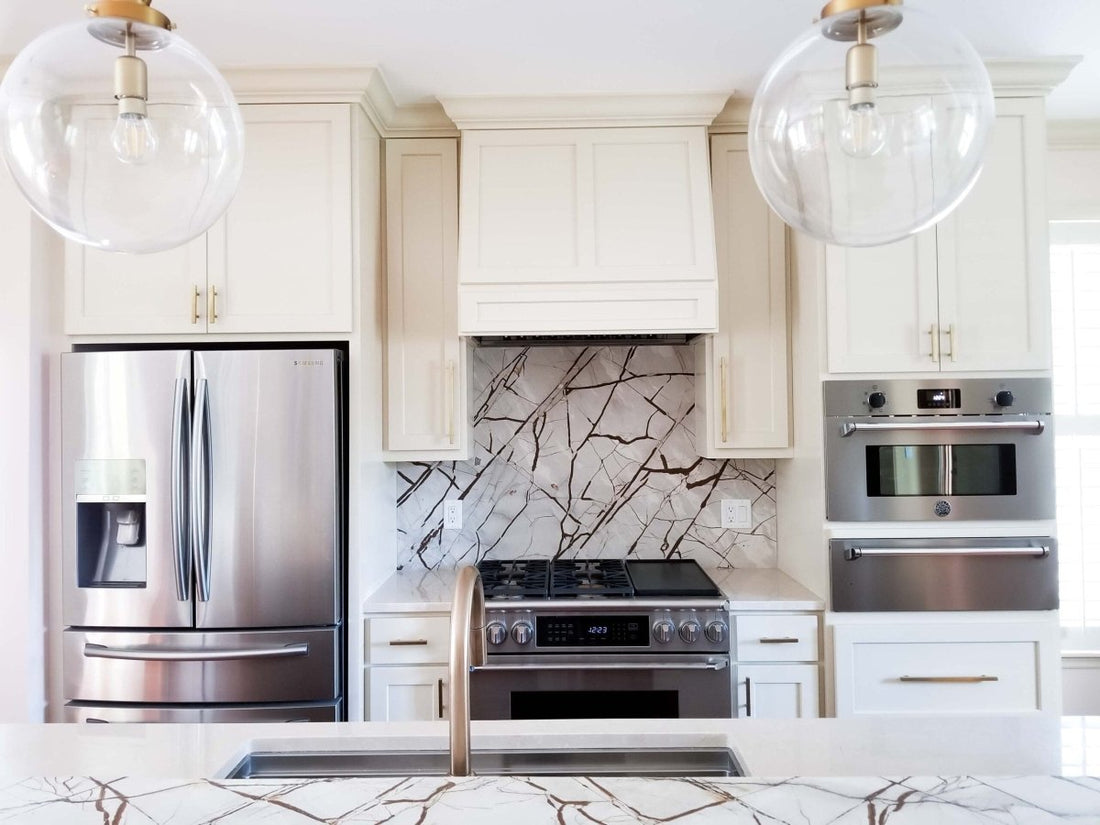Table of Contents
What is a Range Hood Insert?
A range hood insert is a kitchen exhaust fan that fits inside and powers a custom hood. Most residential range hood inserts are between 28" and 60". They typically pull between 600 and 1200 CFM.
You'll sometimes see inserts called liners. These are the exact same thing. Most of them are ducted, but some low-profile inserts can be converted to ductless.
How Do You Pick Out a Range Hood Insert?
Size
Range hood inserts for your home come in 28", 34", 40", 46", 52", and 58".
When buying a range hood insert, you need to determine the size of the opening for your custom hood and the size of the insert.
Ideally, the opening for your custom hood should be six inches larger than your range. For example, if you have a 42" range, cut out an opening that is at least 48" wide.
Your range hood insert will be slightly different. It needs to be two inches smaller to fit comfortably inside the custom hood.
So, in our above example, your insert should be 48" - 2" = 46". Your insert range hood will be in the custom hood for years to come, so you want it to fit smoothly. This will reduce the risk of dents or scratches on your insert in the long run.
Our Recommendation
If possible, buy an insert 10" larger than your kitchen range. This ensures that you have maximum coverage of your cooktop. All the grease and smoke will be moved out of your kitchen much faster with a larger vent hood. If you don't have the space, buy an insert four inches larger than your range.
CFM
Buy an insert that moves at least 600 CFM of air. Unfortunately, you can't increase range hood CFM. So, the more CFM, the better.
Our Recommendation
If you don't cook often, invest in a 600 CFM range hood insert. If you cook 4-5 times a week or more, invest in a 900 CFM insert. Finally, if you enjoy cooking Asian food and greasy food, go with a 1200+ CFM insert.
Blower Type
A high CFM insert range hood isn't as valuable if you don't have a variable speed blower. This allows you to adjust the speed to adapt to your cooking style. Also, you can strategically use the lower speeds to make your hood last longer.
You have three blower options for your range hood insert: local, inline, and remote.
- Local - the blower sits inside the range hood
- Inline - the blower sits inside the ductwork
- Remote - the blower is installed outside the home
Our Recommendation
Variable speed is a must for your insert range hood. We don't recommend an external blower. Even though it's quiet, it is expensive to install and requires more maintenance than other blowers. Inline blowers are a little more expensive to install than local blowers, but they are significantly quieter. So, if you're bothered by noise in the kitchen, an inline blower might be right for you.
Should I Buy a Ducted or Ductless Range Hood Insert?
Ducted range hood inserts vent outside your wall or through your ceiling. A ducted insert vents greasy air through ductwork to the outside of your home.
Unlike ducted insert range hoods, ductless inserts do not vent your greasy kitchen air to the outside. Instead, carbon filters neutralize the cooking odors and capture grease from your kitchen air. Then, that air recirculates back into your home.
Our Recommendation
Ducted insert range hoods are more efficient and effective at removing bad air than ductless. Especially with custom cabinetry or a custom hood surrounding the insert, you want to keep it grease and grime free. In most cases, a ductless insert range hood won't have enough power to keep your kitchen air clean.
What's the Difference Between an Under Cabinet Range Hood and a Range Hood Insert?
Under Cabinet Range Hood
An under cabinet range hood fits under your existing cabinetry and over your stove. It has outer stainless steel housing, so no additional framing is needed or used. They are stand-alone units.

Range Hood Insert
Range hood inserts reside inside custom cabinetry or a custom hood surround. Inserts, or liners as they are sometimes called, are the "guts" of the hood. They can hide from your guests in the kitchen in lots of creative ways.
How to Install a Range Hood Insert
To install a range hood insert, follow these four steps:
- Install the adaptor on the back of your vent hood
- Slide your range hood insert into the back of your custom cabinets or custom hood
- Attach ductwork around the adapter
- Screw the insert into place
Important: Be sure to allow at least 18 inches of straight duct run before installing an elbow, and between elbows.
Learn more HERE!
How to Size a Range Hood Insert
As you may know, range hood inserts are two inches smaller than standard range hoods. For example, while range hoods come in sizes 24", 30", 36", and up to 60", inserts are sized as follows: 28", 34", 40", and up to 58". Learn more here in this blog.
To size your range hood insert, first, measure the width of your range.
Then, add six inches to that measurement for indoor inserts and 12 inches for outdoor inserts. This is the width of the opening in your custom hood – the area where you slide the insert into place.
And finally, subtract two from the width of your custom hood to determine the width of your range hood insert.
For example, let's say you have a 36 inch kitchen range for your indoor kitchen. Your custom hood should be at least 42" wide, which means that you will need an insert that is at least 42" - 2" = 40".
What is the Best Range Hood Insert?
Our Pick - Hurricane Insert
The Hurricane is one of Proline's most popular inserts. It comes with the option of a single 600 CFM blower or dual blowers for a total of 1200 CFM. With its four-speed control panel, you'll have a lot of flexibility and you can adjust the power based on your cooking style.
This hood insert offers great lighting of your cooktop, thanks to dimmable Halogen lights. When you're wrapping up in the kitchen, remove the baffle filters and toss them into the dishwasher for an easy clean.
Sizes: 28", 34", 40", 46", 52", 58"
Each size comes in 15", 18", and 21" depths.
Customer Kitchen Showcases
PLFL 832
The PLFL 832 features stainless steel baffle filters to efficiently filter air out of your kitchen. It includes a single blower that runs at 1000 CFM at max speed and can be adjusted to six different speeds.
This hood produces just 7.5 sones on its highest setting, approximately equal to your average conversation or background noise of a TV.
Sizes: 40", 46", 52", 58"
ProV
The ProV is our most versatile liner. It is rated at 1200, 1300, or 1700 CFM, making it the most powerful product on this list. It includes stainless steel baffle filters and an adjustable knob to change the blower speed however you like.
Sizes: 28", 34", 40", 46", 52", 58"
PLJL
The PLJL liner comes with a powerful 900 CFM blower. At max power, it runs at 7 sones which will allow you to carry on a conversation with your family in the kitchen while it's running!
Sizes: 28", 34", 40", 46"
Each one of these widths comes in two depths: 15" and 18".
We hope you found this information on range hood inserts helpful. If you have any questions, feel free to call us. Thanks for stopping by!
Related Articles
How to Install a Range Hood Insert
3 Best Range Hood Inserts from Proline
111 Inspirational Kitchen Hood Ideas
Ready to transform your custom kitchen with the perfect range hood insert? Browse our complete collection and find the ideal insert for your cooking needs.
Shop Range Hood Inserts
















